MARIANI’SVirtual Gourmet
August 12,
2012
NEWSLETTER
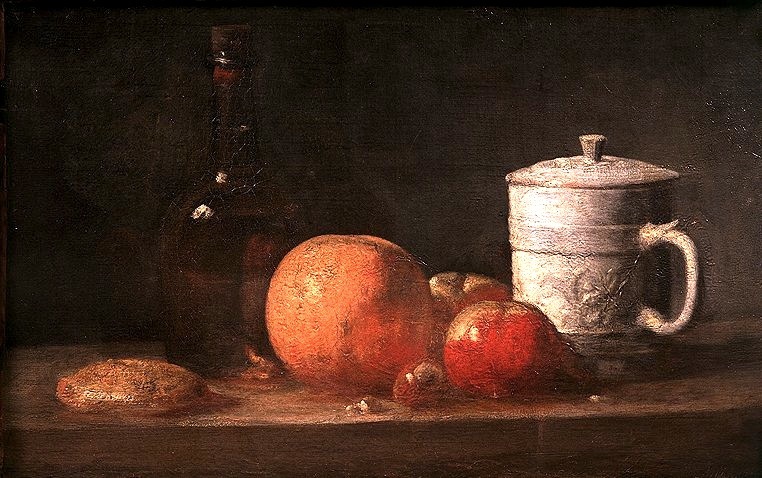
❖❖❖
THIS WEEK
by John Mariani
NEW
YORK CORNER
Bull & Bear
by John
Mariani
NOTES
FROM THE WINE CELLAR
Good Bordeaux Doesn’t
Have to Cost a Fortune
by John Mariani
❖❖❖
STAYING PUT IN RENO
Part One
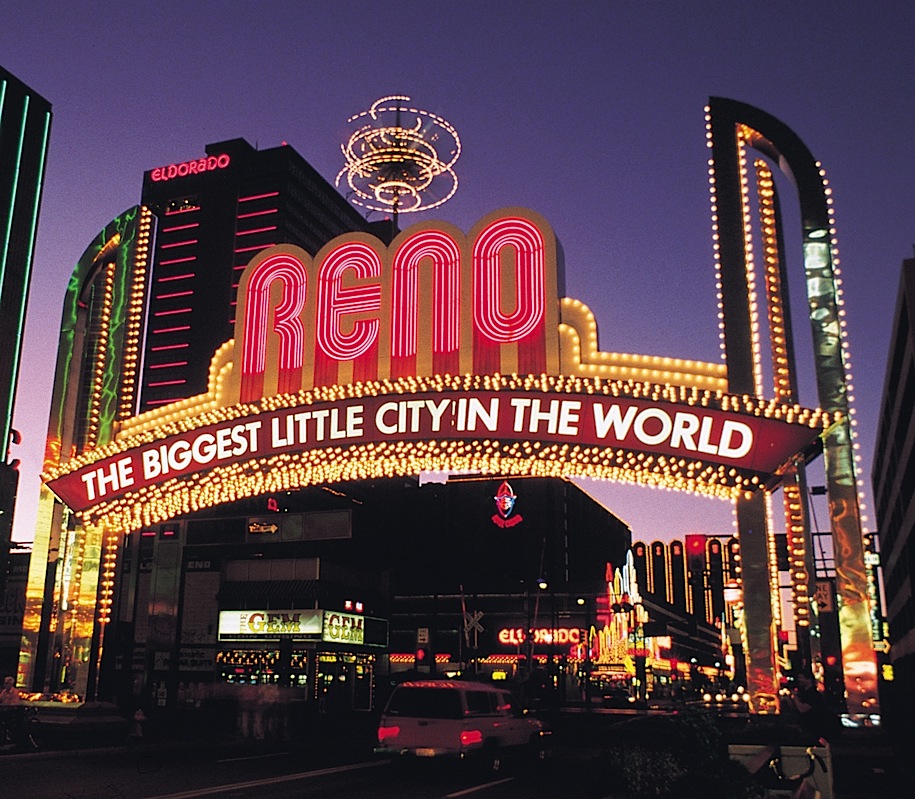
by John Mariani
Reno, Nevada, with a population of 225,000 residents, has not yet ditched its promotional mantra as
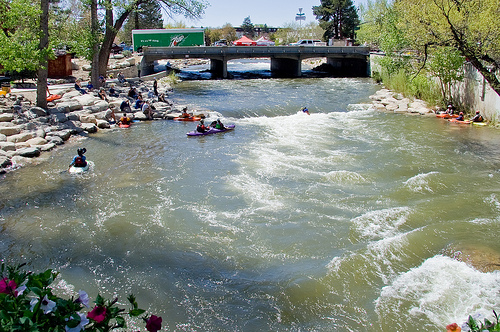 "The Biggest Little City in the
World," but the new ad campaign's slogan is "What's
your passion?"--a reasonable enough query because
Reno, while living in the p.r. shadow of Vegas, is
obviously a far less razzle-dazzle city and one that
offers a whole raft of cultural activities that
Vegas either has or lacks entirely, including a
National Automobile Museum, an Opera, the Pioneer
Center for the Performing Arts, the Reno
Philharmonic, and the Reno Theater Coalition.
"The Biggest Little City in the
World," but the new ad campaign's slogan is "What's
your passion?"--a reasonable enough query because
Reno, while living in the p.r. shadow of Vegas, is
obviously a far less razzle-dazzle city and one that
offers a whole raft of cultural activities that
Vegas either has or lacks entirely, including a
National Automobile Museum, an Opera, the Pioneer
Center for the Performing Arts, the Reno
Philharmonic, and the Reno Theater Coalition.In addition, the city's outdoor parks and riverside show a more habitable, neighborly side of the city, which is added to by opportunities for golf, skiing and snowboarding, with 18 ski resorts in nearby Lake Tahoe, kayaking (right) and white water rafting--there's an annual Reno River Fest--even, since 2005, its own ice skating rink. The city has become the home of the National Bowling Stadium, called the "Taj Mahal of tenpins."
Reno has by far a more low-key atmosphere than Vegas, at least outside of the casinos, which have long been a tourist attraction and money maker, although in recent years nearby Indian casinos in California have siphoned off a good part of that business.
So now the city, which enjoyed an earlier, highly profitable run upon the discovery in 1859 of the Comstock Lode, is now putting its silver into changing its image from a second-tier gambling town to a modern metropolis of enormous diversity, not least by upgrading the international airport (with very easy, sensible access to a rental car right by the gate). And then there's one of those attractions that has a regional, all-American appeal all its own--Reno Aces Baseball Stadium, where you can drop in on a summer's day, buy an inexpensive ticket, and watch players not yet ready for prime time play their hearts out before a crowd that knows them like nephews and neighbors.
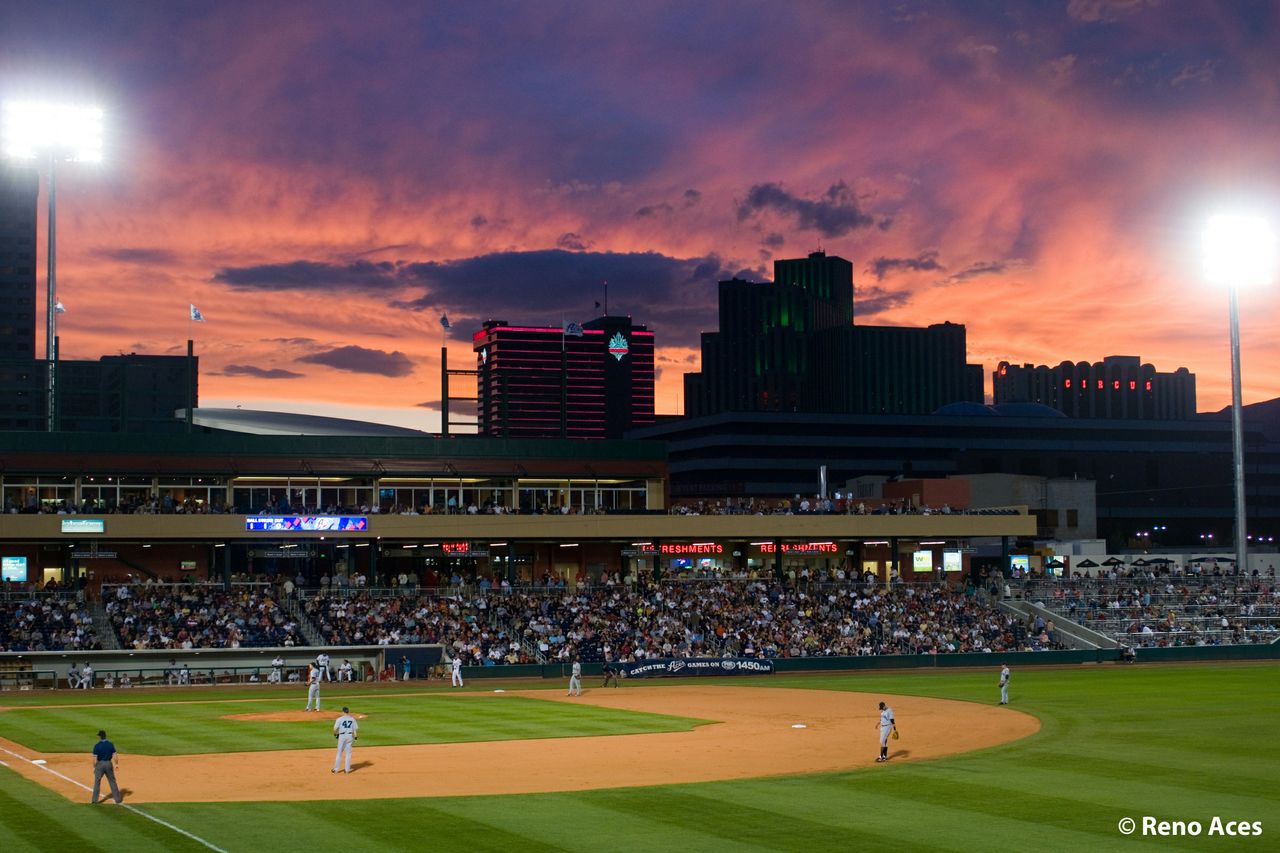 It
was a beautiful blue-sky day with scudding
clouds over the stadium when I attended a
game--the Aces, a Triple A affiliate of the
Arizona Diamondbacks were in a four-game series
with the fearsome-sounding Sacramento River
Cats--sitting smack up behind the protective
chain link fence, where I could watch players in
their livery, many of whom were just big kids,
go intently through all the motions American
boys have for more than a century--the pulls,
the tugs, the nervous hat touches, the signals
that look like tics, the practice swings and
pitches, eyeballing the catcher's
fingers, the nod of the pitcher's head, then the
slider or fast ball and and either the exultant
crack the wooden bat or the solid thunk into the
mitt. All up close. There
as more purity to enterprise, more a game than a
business, far less commercial, but dead
serious to these players just aching to move up
to the majors. More than any overproduced
Major League game could ever be, the Aces game
in Reno seemed
more like a scene out of "Fields of Dreams," in
which James Earl Jones's character says, "The one constant through
all the years has
been baseball. America has rolled by like an army of
steamrollers. It's been
erased like a blackboard, rebuilt, and erased again.
But baseball has marked
the time. This field, this game, is a part of our
past. It reminds us of all
that once was good, and what could be again."
It
was a beautiful blue-sky day with scudding
clouds over the stadium when I attended a
game--the Aces, a Triple A affiliate of the
Arizona Diamondbacks were in a four-game series
with the fearsome-sounding Sacramento River
Cats--sitting smack up behind the protective
chain link fence, where I could watch players in
their livery, many of whom were just big kids,
go intently through all the motions American
boys have for more than a century--the pulls,
the tugs, the nervous hat touches, the signals
that look like tics, the practice swings and
pitches, eyeballing the catcher's
fingers, the nod of the pitcher's head, then the
slider or fast ball and and either the exultant
crack the wooden bat or the solid thunk into the
mitt. All up close. There
as more purity to enterprise, more a game than a
business, far less commercial, but dead
serious to these players just aching to move up
to the majors. More than any overproduced
Major League game could ever be, the Aces game
in Reno seemed
more like a scene out of "Fields of Dreams," in
which James Earl Jones's character says, "The one constant through
all the years has
been baseball. America has rolled by like an army of
steamrollers. It's been
erased like a blackboard, rebuilt, and erased again.
But baseball has marked
the time. This field, this game, is a part of our
past. It reminds us of all
that once was good, and what could be again." 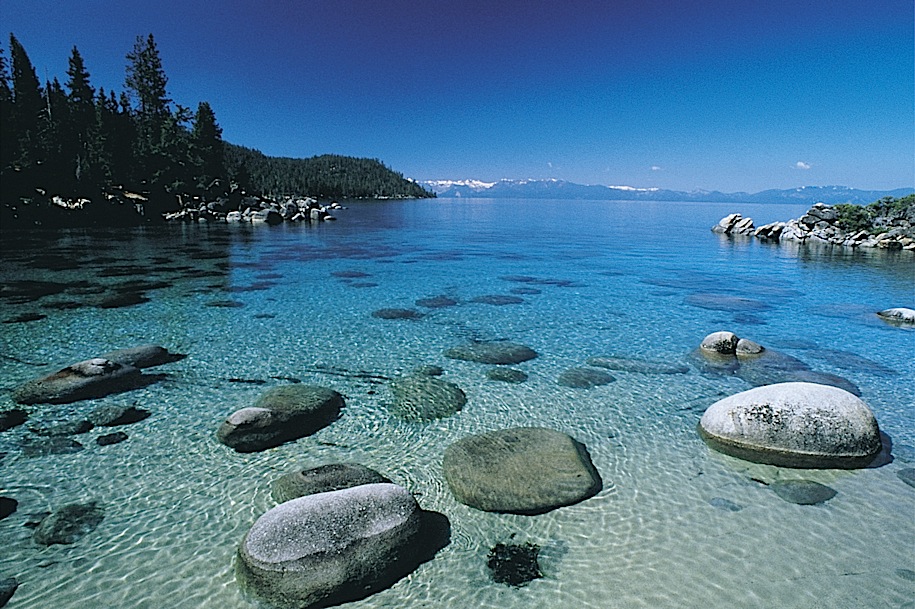
On my
recent visit to Reno I found that, while you could
easily spend several days there taking in its indoor
and outdoor attractions, it is also a city where you
can stay put and easily visit the surrounding
area, the desert and mountains of Nevada and the
extraordinary beauty of the Lake Tahoe region, with
its magnificent depths--more than 1,600 feet--of
crystalline sky blue water. Mark Twain, who on
a hike had difficulty just finding the lake, finally
came upon it and exclaimed, "I thought it must
surely be the fairest picture the whole world
affords."
When I got to Reno, I had in my
head a favorite folk song of the 1960s, written by
Steve Gillett and Tom Campbell, recorded many times
over the years, most famously by Ian and Sylvia and
John Denver. It's the lilting, sad story of a
beautiful girl named Darcy Farrow--"the sweetest
flower that bloomed o'er the range"--who lived in
the Carson Valley, where the Truckee River runs
through, and of how, just before her wedding day,
she was killed in a fall from her horse, causing her
lover, Vandy, to "put a bullet through his brain"
out of grief, and how they 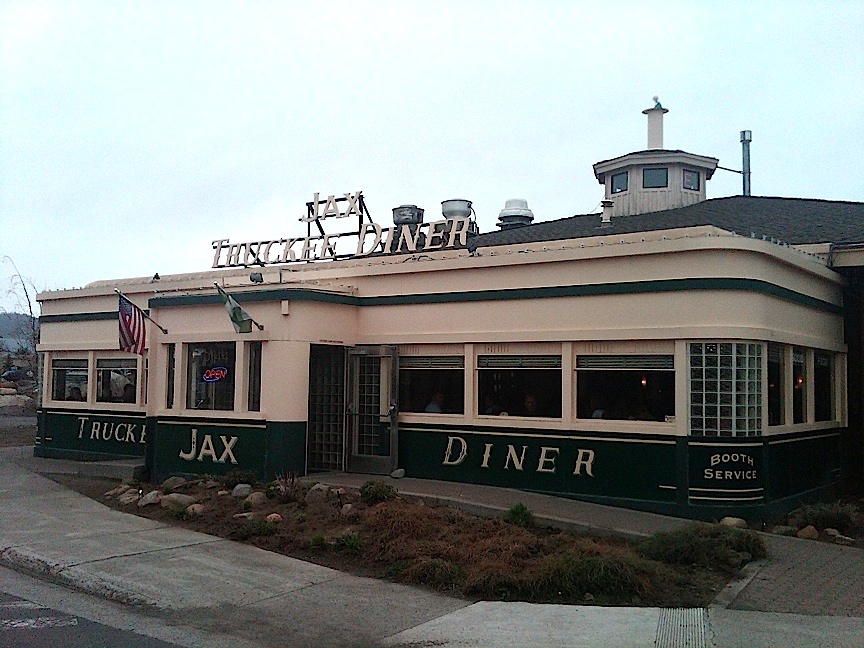 buried them together
before the snow began to fall and how the locals
still sing of the beautiful Darcy Farrow.
buried them together
before the snow began to fall and how the locals
still sing of the beautiful Darcy Farrow.
The story wasn't true, but
Darcy Farrow is a local legend, and the song is full
of geographical references to the territory--the
Walker River, the Carson Valley Plain, the Truckee,
and Virgina City, and I was determined to visit them
all, each part of a folk legend that evoked Sierra
Nevada in a romantic, tragic way. No location
in the song was more than an hour and a half drive
out of Reno, swerving over curving hills and into
the pine mountains, looking down on the Plain and
the silver, winding Truckee.
Truckee itself is located
just across the California border at 6,000 feet, and
the scenery is breathtaking in a way only the West
can be at those mid-elevations, where the air itself
seems freshly churned from the mountain clouds. The
town is small: I walked its length and 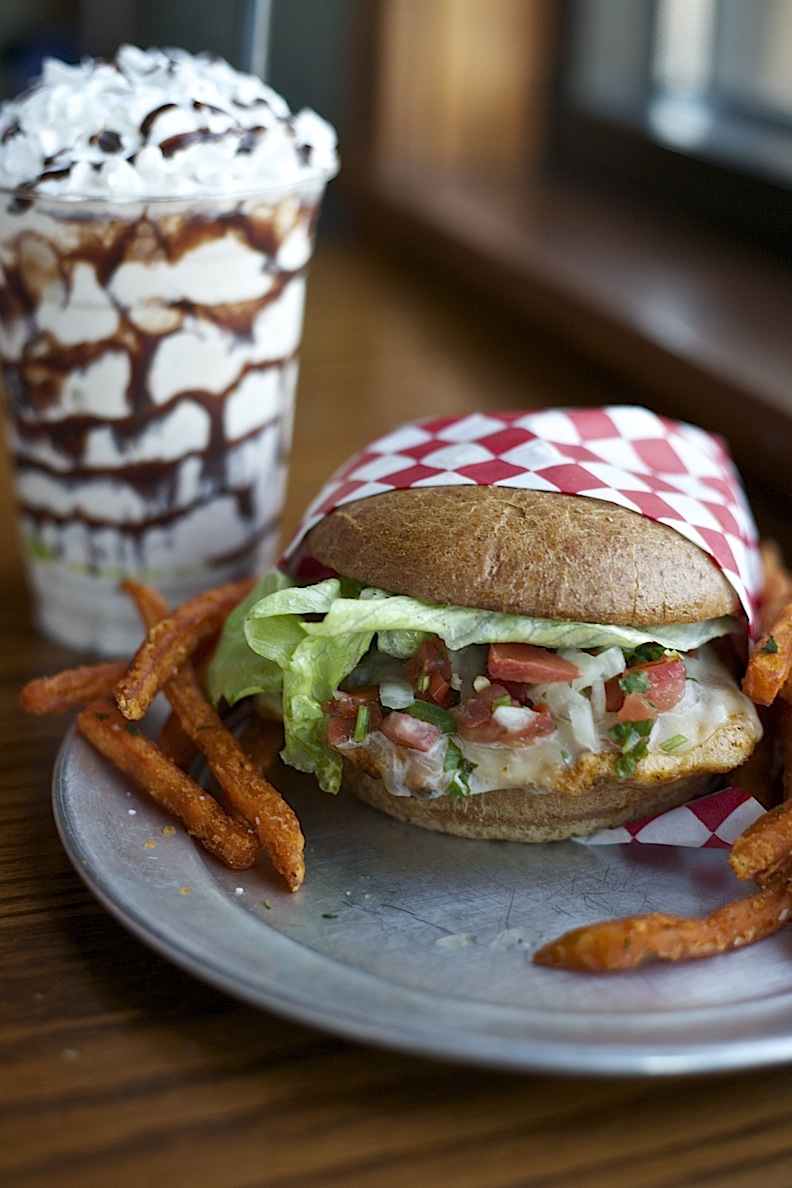 back in
about 20 minutes, and there are some small museums,
an old jail, and the Donner Summit Historical
Society. Various old homes, some in better repair
than others, line the streets along with boutiques
and eateries, the inevitable fudge and candy shop, a
streamlined diner (above),
and a vintage Mobil Flying Horse gas station.
The railroad runs through Truckee making that old
moaning sound that is part animal yell, part
mechanical drone. There's a Capitol Building
that once housed a local opera house, and a Chinese
Herb Shop built in 1878 when the town had the second
largest Chinatown on the west coast. And there are
plenty of B&Bs and restaurants, with wonderful
names like the Blue Coyote Bar and Grill and the
Drunken Monkey.
I had a terrific lunch at Burger Me! (left), which
has outdoor tables. Inside it's a small room usually
filled with people who have known for a while now
that this is one of the best burgers--in all
varieties--anywhere, a recognition I made upon
biting into the well-fatted beef patty mounted with
add-ons of caramelized onions, pepperjack cheese,
even sauerkraut, avocado, a fried egg and bacon (right). The
Truckee Trainwreck variation included onion ring and
turkey chili, while the BBQ bison burger gets a
layer of smoked Cheddar, jalapeño peppers and
BBQ sauce. Even the unorthodox ahi tuna burger
works well here, and you won't easily find better
sweet potato fries or onion rings in the West.
Oh, and they make a stellar milkshake too.
back in
about 20 minutes, and there are some small museums,
an old jail, and the Donner Summit Historical
Society. Various old homes, some in better repair
than others, line the streets along with boutiques
and eateries, the inevitable fudge and candy shop, a
streamlined diner (above),
and a vintage Mobil Flying Horse gas station.
The railroad runs through Truckee making that old
moaning sound that is part animal yell, part
mechanical drone. There's a Capitol Building
that once housed a local opera house, and a Chinese
Herb Shop built in 1878 when the town had the second
largest Chinatown on the west coast. And there are
plenty of B&Bs and restaurants, with wonderful
names like the Blue Coyote Bar and Grill and the
Drunken Monkey.
I had a terrific lunch at Burger Me! (left), which
has outdoor tables. Inside it's a small room usually
filled with people who have known for a while now
that this is one of the best burgers--in all
varieties--anywhere, a recognition I made upon
biting into the well-fatted beef patty mounted with
add-ons of caramelized onions, pepperjack cheese,
even sauerkraut, avocado, a fried egg and bacon (right). The
Truckee Trainwreck variation included onion ring and
turkey chili, while the BBQ bison burger gets a
layer of smoked Cheddar, jalapeño peppers and
BBQ sauce. Even the unorthodox ahi tuna burger
works well here, and you won't easily find better
sweet potato fries or onion rings in the West.
Oh, and they make a stellar milkshake too.
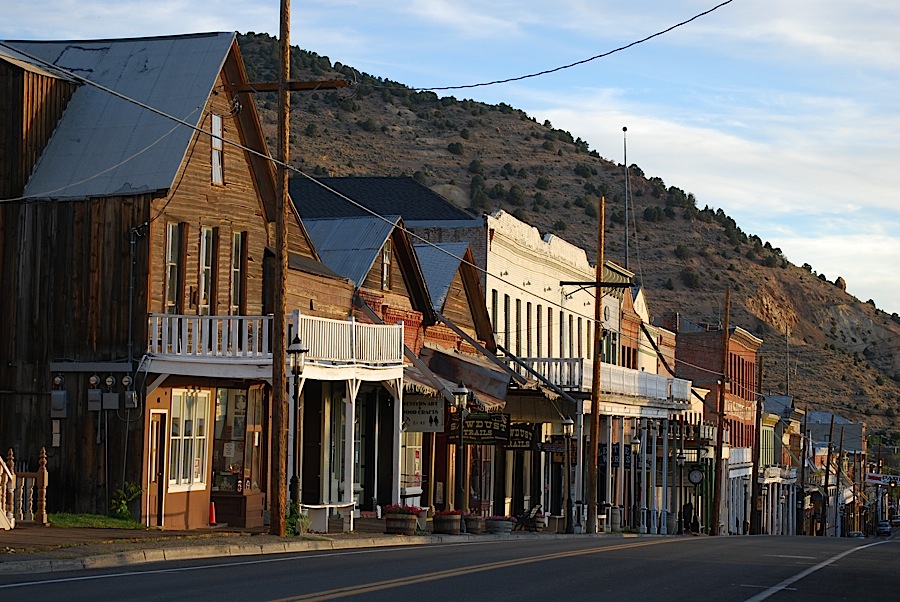 Another
famous American, bon vivant, Lucius Beebe, bought
the same newspaper in 1950 and wrote the
long-running "That Was the West" series.
Today, Virginia City is a quaint relic of those
mining-mad days of the mid-19th century, retaining
the look it must have acquired by the turn of the
century, but now with a population of less than 900
residents.
Another
famous American, bon vivant, Lucius Beebe, bought
the same newspaper in 1950 and wrote the
long-running "That Was the West" series.
Today, Virginia City is a quaint relic of those
mining-mad days of the mid-19th century, retaining
the look it must have acquired by the turn of the
century, but now with a population of less than 900
residents. The streets are lined, if not every fifteen feet, with saloons, very old ones like the Bucket of Blood and Red Dog Saloon, along with the usual t-shirt and souvenir shops. The millionaires of that earlier era would assemble to toast themselves at the still extant Washoe Club. A contemporary attraction is Barrels O Candy, which is just that, a big room with scores of barrels brimming with every candy you have ever heard of; every one I remember from my own childhood has found a home here, from Turkish taffy to Nik-L-Nips in little wax bottles. Red Hots, Caramello, Walnettos, Dots, HeatH bars, even candy cigarettes.
Then, if you haven't been dazzled enough by all that packaged candy, there's the charming Grandma's Fudge, where the aroma of chocolate, vanilla and butter cream can put the receptive visitor in a stupor. We drove back to Reno, and that night, I had sweet dreams.
PART TWO of this article, on where to eat in Reno, will appear next week.
❖❖❖
NEW
YORK CORNER
by
John Mariani
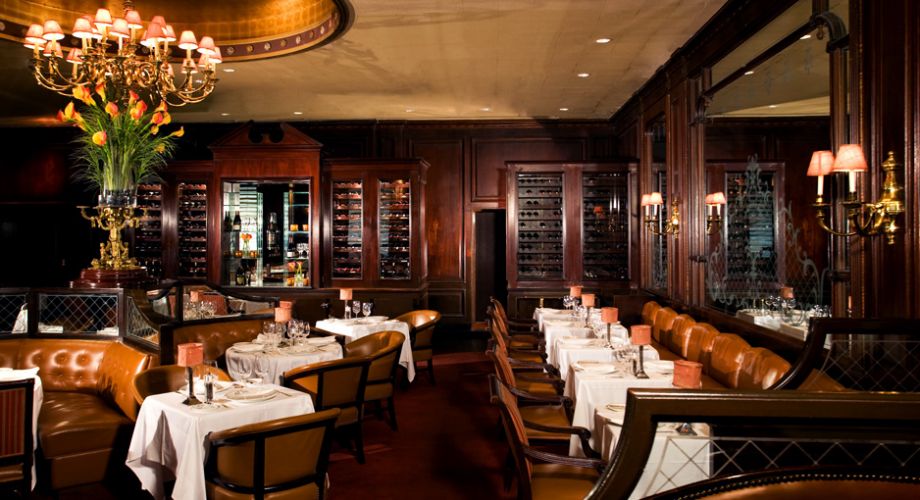 Bull
&Bear
Bull
&Bear
Waldorf-Astoria Hotel
301 Park Avenue
800-925-3673
www.waldorfnewyork.com
The Bull & Bear has been around since the beginning (right), and it still wears its historic posh well, with
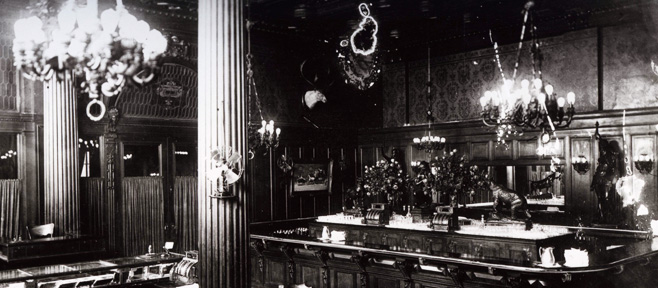 acres of mahogany and fine
game paintings, well-draped tables and very comfortable
chairs, its bi-level arrangement from a day when
the idea of Siberia seating ruled, as overseen by the
notorious maître d' Oscar Tschirky, who ruled over
NYC Society with a flick of his chin.
acres of mahogany and fine
game paintings, well-draped tables and very comfortable
chairs, its bi-level arrangement from a day when
the idea of Siberia seating ruled, as overseen by the
notorious maître d' Oscar Tschirky, who ruled over
NYC Society with a flick of his chin.Today service is far more egalitarian, and getting a table overlooking Lexington Avenue is not as hard as it might once have been. The menu has long been geared to steaks and chops, but there's a good deal more on the menu to choose from, done with a more refinement than at some of the brusque independent steakhouses in the neighborhood.
The Bull & Bear seems entirely right for the kind of dinner that 19th century Gotham tycoons would tuck into night after night, and many of those same items they would have gorged on are still here for your delectation. That means appetizers of fat shrimp cocktail and, of course,
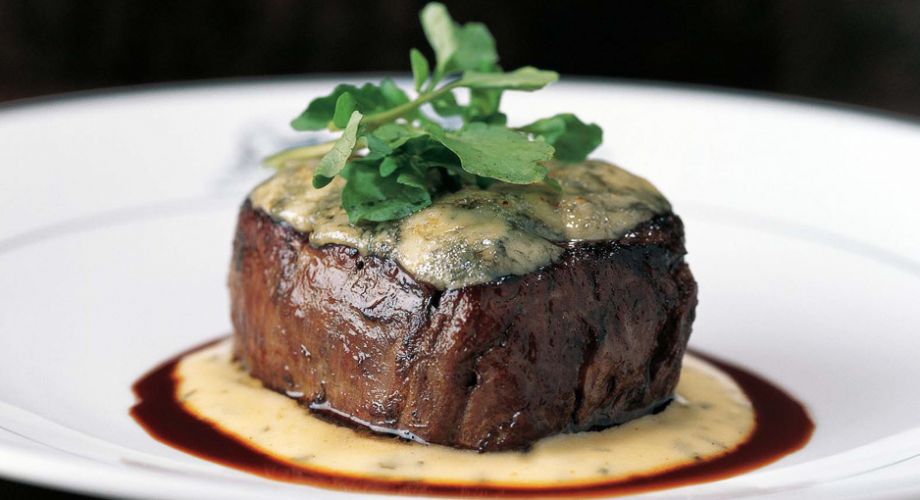 the Waldorf
salad, with candied walnuts, sweet and sour apples,
celeriac and truffle. There is a first-rate onion soup
gratinée here, thick, not too much bread, gobs of
Gruyère, and the right steaming temperature.
Yellowfin tuna tartare is a stand-out dish here, but the
Maine peekytoe crabcake with fines herbes aïoli has
disappointingly too much filler rather than large lump
crab.
the Waldorf
salad, with candied walnuts, sweet and sour apples,
celeriac and truffle. There is a first-rate onion soup
gratinée here, thick, not too much bread, gobs of
Gruyère, and the right steaming temperature.
Yellowfin tuna tartare is a stand-out dish here, but the
Maine peekytoe crabcake with fines herbes aïoli has
disappointingly too much filler rather than large lump
crab. My favorite appetizer was an old favorite indeed--the Bull & Bear Wedge, a large slice of really crisp, cold Iceberg lettuce with that wonderful loud crunch, served with ripe tomatoes, tangy red onion, Maytag blue cheese, bacon and egg--almost a meal in itself.
Beef is obviously the draw here, but I'm sorry to say that while of good Prime quality, the dry-aged NY strip did not have the marbling so desirable in this cut of beef. A Black Angus filet mignon (left) was thick and good. There is a choice of various sauces to go with the beef, but they will cost you extra, and at these prices, you'd think they'd throw in a spoonful or two of Béarnaise.
I do applaud the caliber of B&B's Colorado rack of lamb, succulent, nicely trimmed yet retaining all the right fat in the right places on a generous rack. Dover sole meunière was also of top quality in terms of the fish's fattiness and the lemon brown butter used.
Two side dishes missed, especially not-cooked-through au gratin potatoes we sent back in favor of fine buttery mashed potatoes; creamed baby spinach could have used a good shot more of cream and butter.
Desserts are not out of the ordinary but, like the crème brûlée and cheesecake, well rendered. The wine list is hefty with high-end items, and needs a lot more bottles under $50.
Open for dinner nightly. Appetizers $14-$24, main courses $46-$95.
❖❖❖
NOTES FROM THE WINE CELLAR
Good
Bordeaux
Doesn’t Have to Cost a Fortune
by John Mariani
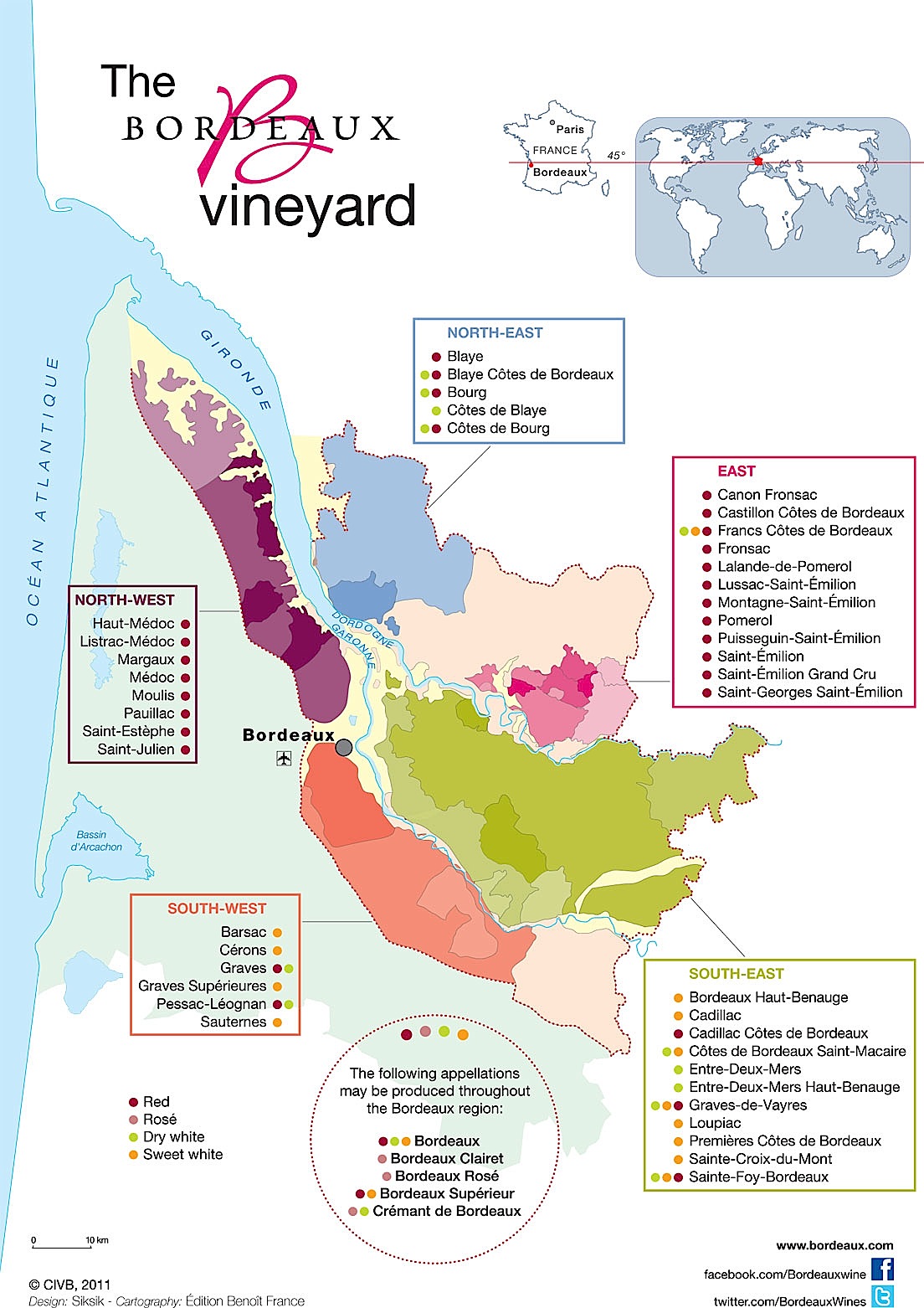 As the
market and auction prices for First Growth Bordeaux
soar to levels only one-percenters can afford, one
would think that such inflation would lift the
prices for all Bordeaux wines. Yet, while the First
Growths get all the hype and stratospheric
prices—twelve bottles of 2008 Lafite-Rothschild
recently sold at auction for $11,000—the prices for
Second- through Fifth Growths have shown little in
the way of inflation.
As the
market and auction prices for First Growth Bordeaux
soar to levels only one-percenters can afford, one
would think that such inflation would lift the
prices for all Bordeaux wines. Yet, while the First
Growths get all the hype and stratospheric
prices—twelve bottles of 2008 Lafite-Rothschild
recently sold at auction for $11,000—the prices for
Second- through Fifth Growths have shown little in
the way of inflation.
But the real story—the bargain
bin, if you will—for Bordeaux is in the unheralded
estates and appellations that fall into categories
as Bordeaux Supérieur and local names like
Fronsac, Côtes de Bourg, Cadillac, Côtes
de Castillon and others that make up 95 percent of
the region’s wines, which is, after all, what the
French drink on an everyday basis.
Owing to a summer sale at New
York’s Sherry-Lehmann wine store, I stocked up on
Bordeaux from such unheralded appellations and have
been drinking them with pleasure, sometimes with
real surprise.
It hardly needs noting that none rises to the
levels of complexity that one finds in First and
Second Growths, but I would be hard put to discern
many from an array of Third, Fourth and Fifth
Growths. And the prices range from just $13 to $20.
The vintages went from 2006 to 2010, and all
of them were ready to drink right now, although a
year or two more on some of the more recent
vintages will prove interesting. All were
typical Bordeaux blends of cabernet sauvignon,
merlot, malbec, and cabernet franc. None had an
alcohol level above 14.5 percent by volume. (The
prices below are those I paid on sale, but they may
be higher or lower elsewhere.)
Château de Maison Neuve 2009
($16)—This wine is from Montagne-Saint Emilion,
where merlot dominates, so this had a bold body
whose tannins are softened for balance. If you close
your eyes and don’t look at the label, you may taste
a hint of the illustrious Cheval Blanc and Ausone
from the same region of Saint Émilion.
Chateâu Jouanin 2009 ($14)—From
Castillon, on the right bank of the Dordogne River,
where the wines are known for their structure, this
is a blend of 70 percent merlot, the rest cabernet
sauvignon and cabernet franc that shows a fine
equilibrium between its fruits and acids and robust
tannins buoyed it. It was a terrific match with
charcoal-broiled porterhouse steak and corn on the
cob. 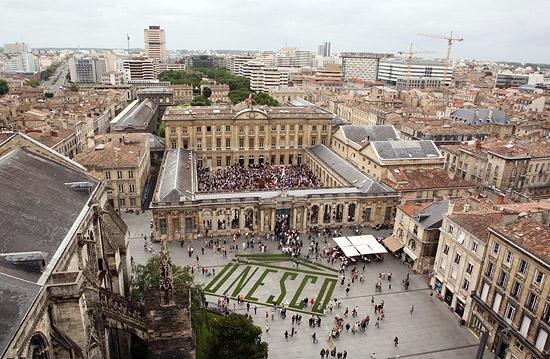
Château Labatut-Bouchard 2009
($13)—Made in a region called Cadillac better known
for its sweet wines, this remarkably priced red is a
juicy glory, full flavored, deep in color and
bouquet, and certainly worth its label proclamation
as a “Grand Vin de Bordeaux.”
Château Le Bonnat 2008 ($17)—Made
from wines that average 30-40 years old and owned
since 1997 by the Lesgourgues family, Le Bonnat is a
good example of modern French winemaking that brings
out the best from a clay and limestone soil in the
Graves region, known for the silkiness of its wines.
It’s not Haut-Brion but it has complex density and a
lovely smoky quality.
Château Mayne-Vieil 2009
($16)—This big blend of mostly merlot and cabernet
franc from the Fronsac region in eastern Bordeaux
may take a few years to show all its virtues, for
its tannins are still firm and its character hearty.
Although modern winemaking has softened up Fronsac
reds in recent years, one can still taste its
traditional rustic charm, which makes it a good
choice for a lamb stew or cassoulet this
fall.
The city of
Bordeaux
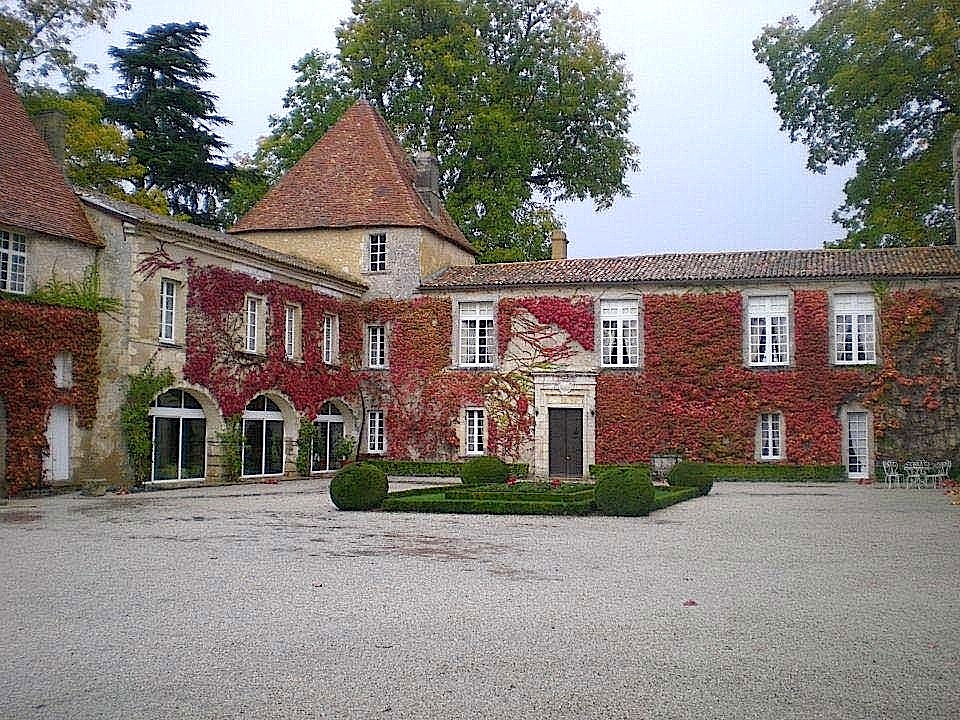 Château
Thébot 2009 ($14)—Though it has a simple
Bordeaux appellation, the wine is made from 75
percent merlot, and the first sip is impressive for
its fist of fruit and tannins—it’s 14.5 percent
alcohol—but the wine keeps revealing more fruit
character as you drink it with food.
Château
Thébot 2009 ($14)—Though it has a simple
Bordeaux appellation, the wine is made from 75
percent merlot, and the first sip is impressive for
its fist of fruit and tannins—it’s 14.5 percent
alcohol—but the wine keeps revealing more fruit
character as you drink it with food.
Château Haut Maginet 2009
($11)—For eleven bucks, this is a real winner and
has the true taste of Bordeaux—brick, dark cherries
and spices, with a delicious peppery component and
an admirable 13.5 percent alcohol. Slog it back with
anything from a hamburger to roast chicken and
French fries.
Château Tour Léognan (left) 2008
($20)—This is the second-tier wine from Grave’s
Château Carbonnieux, better known for its
white wine. Cabernet sauvignon makes up 55 percent
of the blend, but it’s mellowed out now and shows
the kind of breeding such a respected estate can
bring. It’s
the kind of wine I’d bring to a friend’s house to
surprise him with its high quality.
❖❖❖
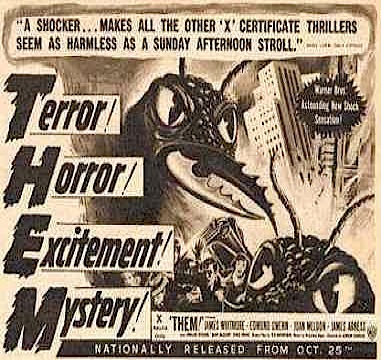 IF WE THROW UP, DO WE STILL
IF WE THROW UP, DO WE STILL
HAVE TO PAY
FOR THEM?
René
Redzepi, chef-owner of Copenhagen's Noma,
is reportedly testing dishes with live ants and
yogurt,
saying, "I like the acidity that comes from the ant,
almost citrus-like, especially in combination with
fresh, natural yogurt."
 UH-HUH
UH-HUH"I’m face to face with a magnificent, giant slab of rosy prime rib. At 28 ounces,
and standing at least 3 inches tall, it has to be the biggest one I’ve ever met."
--Leslie Brenner, "Al Biernat's," Dallas Morning News
Any of John Mariani's
books below may be ordered from amazon.com.
 |
My latest book, which just won the prize for best book from International Gourmand, written with Jim Heimann and Steven Heller, Menu Design in America, 1850-1985 (Taschen Books), has just appeared, with nearly 1,000 beautiful, historic, hilarious, sometimes shocking menus dating back to before the Civil War and going through the Gilded Age, the Jazz Age, the Depression, the nightclub era of the 1930s and 1940s, the Space Age era, and the age when menus were a form of advertising in innovative explosions of color and modern design. The book is a chronicle of changing tastes and mores and says as much about America as about its food and drink.
“Luxuriating vicariously in the pleasures of this book. . . you can’t help but become hungry. . .for the food of course, but also for something more: the bygone days of our country’s splendidly rich and complex past. Epicureans of both good food and artful design will do well to make it their coffee table’s main course.”—Chip Kidd, Wall Street Journal.
“[The menus] reflect the amazing craftsmanship that many restaurants applied to their bills of fare, and suggest that today’s restaurateurs could learn a lot from their predecessors.”—Rebecca Marx, The Village Voice. |
"Eating Italian will never be the same after reading John Mariani's entertaining and savory gastronomical history of the cuisine of Italy and how it won over appetites worldwide. . . . This book is such a tasteful narrative that it will literally make you hungry for Italian food and arouse your appetite for gastronomical history."--Don Oldenburg, USA Today. "Italian
restaurants--some good, some glitzy--far
outnumber their French rivals. Many of
these establishments are zestfully described
in How Italian Food Conquered the World, an
entertaining and fact-filled chronicle by
food-and-wine correspondent John F.
Mariani."--Aram Bakshian Jr., Wall Street
Journal.
"Equal parts
history, sociology, gastronomy, and just
plain fun, How Italian Food Conquered the
World tells the captivating and delicious
story of the (let's face it) everybody's
favorite cuisine with clarity, verve and
more than one surprise."--Colman Andrews,
editorial director of The Daily
Meal.com. "A fantastic and fascinating
read, covering everything from the influence
of Venice's spice trade to the impact of
Italian immigrants in America and the
evolution of alta cucina. This book will
serve as a terrific resource to anyone
interested in the real story of Italian
food."--Mary Ann Esposito, host of PBS-TV's
Ciao
Italia. "John Mariani has written the
definitive history of how Italians won their
way into our hearts, minds, and
stomachs. It's a story of pleasure over
pomp and taste over technique."--Danny Meyer,
owner of NYC restaurants Union Square Cafe,
Gotham Bar & Grill, The Modern, and
Maialino.
|
 |
 |
 |
 |
 |
 |
 |
 |
 Everett Potter's Travel Report:
Everett Potter's Travel Report: 
 Eating Las Vegas
is the new on-line site for Virtual Gourmet
contributor John A. Curtas., who since 1995
has been commenting on the Las Vegas food
scene and reviewing restaurants for Nevada
Public Radio. He is also the
restaurant critic for KLAS TV, Channel 8 in
Las Vegas, and his past reviews can be
accessed at KNPR.org.
Click on the logo below to go directly to
his site.
Eating Las Vegas
is the new on-line site for Virtual Gourmet
contributor John A. Curtas., who since 1995
has been commenting on the Las Vegas food
scene and reviewing restaurants for Nevada
Public Radio. He is also the
restaurant critic for KLAS TV, Channel 8 in
Las Vegas, and his past reviews can be
accessed at KNPR.org.
Click on the logo below to go directly to
his site.

Tennis Resorts Online: A Critical Guide to the World's Best Tennis Resorts and Tennis Camps, published by ROGER COX, who has spent more than two decades writing about tennis travel, including a 17-year stretch for Tennis magazine. He has also written for Arthur Frommer's Budget Travel, New York Magazine, Travel & Leisure, Esquire, Money, USTA Magazine, Men's Journal, and The Robb Report. He has authored two books-The World's Best Tennis Vacations (Stephen Greene Press/Viking Penguin, 1990) and The Best Places to Stay in the Rockies (Houghton Mifflin, 1992 & 1994), and the Melbourne (Australia) chapter to the Wall Street Journal Business Guide to Cities of the Pacific Rim (Fodor's Travel Guides, 1991).


MARIANI'S VIRTUAL GOURMET
NEWSLETTER is published weekly. Editor/Publisher: John
Mariani.
Contributing Writers: Christopher Mariani, Robert Mariani,
John A. Curtas, Edward Brivio, Mort Hochstein,
Suzanne Wright, and Brian Freedman. Contributing
Photographers: Galina Stepanoff-Dargery,
Bobby Pirillo. Technical Advisor: Gerry McLoughlin.
© copyright John Mariani 2012
